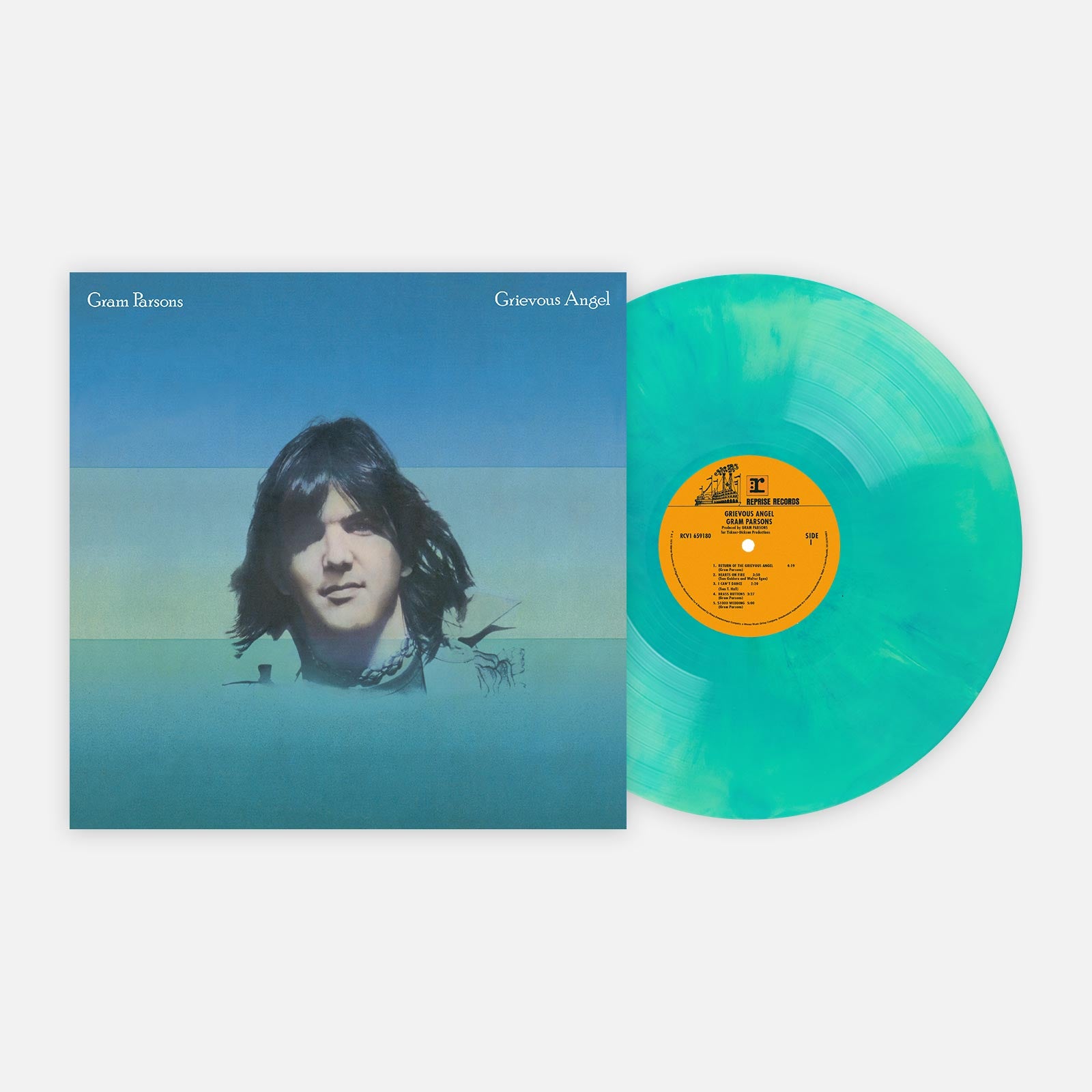แกรม พาร์สันส์ ก่อนชั่วโมงแห่งความมืด
แยกตำนานออกจากดนตรีใน ‘Grievous Angel’
ขอบคุณภาพจาก gramparsons.com
เมื่อแกรม พาร์สันส์ เสร็จสิ้นการบันทึกเสียง Grievous Angel เขาโทรหาน้องสาวของเขา อาวิ ส เพื่อบอกว่าเขาภูมิใจในผลงานล่าสุดของเขา “GP ก็ดี” เขากล่าวถึงอัลบั้มแรกของเขา ตามที่อาวิได้บันทึกไว้ในชีวประวัติของพาร์สันส์ที่เขียนโดยเบน ฟอง-ทอเรส Hickory Wind: The Life and Times of Gram Parsons แต่ Grievous Angel ศิลปินทั้งหลายบอกกับน้องสาวคนเล็กของเขาว่า “มันเป็นสิ่งที่ฉันอยากจะทำมากกว่า”
มันเป็นปลายฤดูร้อนในปี 1973 เพียงไม่กี่สัปดาห์ก่อนที่พาร์สันส์จะถูกพบว่าเสียชีวิตจากการใช้ยาเกินขนาดในห้องพักโรงแรมที่โจซัวทรีในวัย 26 ปี นักร้องจากแคลิฟอร์เนียคนนี้ได้จางหายไปอย่างช้า ๆ ในความกลืนกินของยาเสพติดและแอลกอฮอล์มาหลายปี เมื่อเขาเข้าสตูดิโอในลอสแองเจลิสเพื่อเริ่มทำงานในอัลบั้มที่สองซึ่งจะเป็นอัลบั้มสุดท้ายของเขา จนถึงขนาดที่พาร์สันส์ซึ่งเป็นนักแต่งเพลงที่ค่อนข้างอุดมสมบูรณ์ตลอดอาชีพที่สั้นของเขา ได้เขียนเพลงใหม่ทั้งหมดเพียงเพลงเดียวสำหรับเซสชัน Grievous Angel ที่กำลังจะมาถึง เพลงนั้นมีชื่อว่า “In My Hour of Darkness.”
“และฉันรู้ว่าช่วงเวลาของเขาจะมาถึงในไม่ช้า” พาร์สันส์ร้องในบัลลาดที่เศร้าโศก “แต่ฉันไม่รู้ว่าเมื่อไหร่”
เมื่อพี่สาวของเขา อวีส์ มองย้อนกลับไปที่อัลบั้มในหลายปีต่อมา เธอไม่เห็นผลงานอันยิ่งใหญ่ที่พาร์สันส์บอกเธอว่าเขาได้สร้างขึ้น; เธอได้ยินคำอำลา “เขาต้องการจะออกไปในแสงที่สดใสแทนที่จะจางหายไป” เธอบอกกับฟอง-ทอเรส “ดูว่าเขารวบรวมตัวเองได้ดีแค่ไหนสำหรับอัลบั้มสุดท้าย มันน่าพอใจจริง ๆ ฉันโมโหเขาจริง ๆ”
ในระยะเวลาเกือบ 50 ปีนับตั้งแต่การปล่อยอัลบั้ม Grievous Angel หลังจากที่เขาเสียชีวิตในปี 1974 ตำนานและมรดกของแกรม พาร์สันส์ได้ขยายออกไปเป็นสิ่งที่มากกว่าตำนาน นักร้องนักแต่งเพลงที่เดินทางได้ใช้เวลาประมาณเจ็ดปีหมุนเวียนกับวงดนตรีหลาย ๆ วงในความพยายามที่จะผสมผสานดนตรีคันทรีจากจอร์เจียใต้บ้านเกิดของเขากับร็อค ป๊อป และฟอลค์ที่เบ่งบานในลอสแองเจลิสในช่วงปลายปี 1960 โดยแทบไม่มีความสำเร็จเชิงพาณิชย์เลย แต่ตั้งแต่เขาเสียชีวิต พาร์สันส์กลายเป็นอวตารและเสาหลักสำหรับหลายรุ่นของศิลปินที่พยายามนำเสนอองค์ประกอบของดนตรีคันทรีอเมริกันแบบดั้งเดิมและดนตรีรากในบริบทที่ไม่เฉพาะเจาะจงกับคันทรี
ที่ยั่งยืนที่สุด พาร์สันส์ร่วมเขียนเพลงหลายเพลง (“Sin City” และ “Hickory Wind” รวมอยู่ด้วย) ในชีวิตของเขาที่กลายเป็นมาตรฐานที่แท้จริงนับตั้งแต่เขาเสียชีวิต “Hickory Wind” เพียงเพลงเดียว — ดูโอที่เจ็บปวดกับคู่หูสร้างสรรค์หลักของเขา เอ็มมีลู แฮร์ริส — ได้ถูกคัฟเวอร์โดยลูซินดา วิลเลียมส์, กิลเลียน เวลช์, โจน บาเอซ, เจย์ ฟาร์ราร์, นอราห์ โจนส์, บิลลี่ สตริงส์, แอชลีย์ มอนโร, คีธ ไวท์ลีย์, โม พิตนีย์, ทัทเทิล และเพื่อนเก่าของพาร์สันส์ คีธ ริชาร์ดส์
นานหลังจากนั้น ศิลปินที่หลากหลายเช่น วิลโก้, เชอรีล โครว์, เลมอนเฮดส์ และวิสกี้ทาวน์ ต่างแสดงความจงรักภักดีต่อพาร์สันส์ในช่วงอัลท์คันทรีในยุค 90 และดนตรีของนักร้องนักแต่งเพลงยังคงมีอิทธิพลอยู่มาก รัสตัน เคลลี่ และแอชลีย์ มอนโรได้ปล่อยคัฟเวอร์เวอร์ชันการร้องของแฮร์ริสและพาร์สันส์ในเพลง “Love Hurts” ในระหว่างการระบาดของ COVID-19 ดูโอรูท-ป๊อปสวีเดน ฟิร์สท์ เอด คิท ได้เกิดขึ้นในอเมริกาในช่วงต้นปี 2010 ด้วย “Emmylou” ซึ่งเป็นบทกวีโรแมนติกเกี่ยวกับดนตรีของแฮร์ริสและพาร์สันส์ พร้อมด้วยมิวสิกวิดีโอที่มีบรรยากาศเหมือนรำลึกซึ่งถูกถ่ายทำในโจซัว ทรี ที่พาร์สันส์รัก สองพี่น้องได้ค้นพบแฮร์ริสโดยการฟังดูโอเพลงของเธอบน Grievous Angel.
“มันเป็นการเปิดเผยสำหรับเรา” พวกเธอกล่าวถึงการได้ยินดนตรีของพาร์สันส์และแฮร์ริสเป็นครั้งแรก
ดนตรีของพาร์สันส์ได้มอบความรู้สึกการเปิดเผยนั้นมาเกือบ 50 ปีแล้ว นำเสนอสิ่งที่ตอนนี้รู้สึกเหมือนเป็นวิสัยทัศน์ที่ไร้ที่ติของสิ่งที่หมายถึงการรวมการฮองกี้-ท็องค์ที่มีพลังของจอร์จ โจนส์และร็อคแอนด์โรลที่คึกคักของเอลวิส เพรสลีย์เข้ากับการบัลลาดฟอลค์-ป๊อปของเดอะเอเวอรี บราเธอส์ อย่างไรก็ตาม ตามที่สามารถพบได้บ่อยในงานปล่อยหลังจากการเสียชีวิต มันแทบจะเป็นไปไม่ได้ที่จะทำให้ตำนานของ Grievous Angel แยกจากดนตรีของมัน การอยู่ท่ามกลางออร่าผ่านเลนส์ 20/20 ของการตายอันน่าสลดใจของพาร์สันส์ อัลบั้มนี้ไม่เคยหยุดเติบโตในสถานะ
แม้ในช่วงชีวิตของเขา พาร์สันส์ก็รับรู้ตำนานของตัวเองมาโดยตลอด พาร์สันส์ซึ่งแม่ของเขาเป็นส่วนหนึ่งของครอบครัวที่มีปัญหาในฟลอริดาที่ดูแลความมั่งคั่งในการผลิตมะนาว เป็นคนที่บางครั้งรู้สึกว่านี่คือคนที่ใช้ชีวิตอย่างรุนแรงซึ่งมีเรื่องราวเบื้องหลังและออร่าของความประมาทที่นำมาซึ่งความสนใจในสื่อร็อคมากกว่านักร้องคันทรีคนอื่นในยุคนั้น
“พาร์สันส์เป็นเด็กจากจอร์เจียใต้ที่มีการศึกษาจากฮาร์วาร์ด มรดกใหญ่ และมีแนวโน้มที่จะซึมเศร้า” บัด สก็อปปาแห่ง Rolling Stone เขียนในช่วงต้นปี 70 “ธีมหลักของเขามักจะเป็นเด็กใต้ที่ไร้เดียงสาที่ถูกโยนเข้ามาระหว่างประเพณีที่เข้มแข็งและหลักจริยธรรมที่เข้มงวดที่เขาเกิดมาอยู่กับโลกสมัยใหม่ที่ซับซ้อนและคลุมเครือ เขาตระหนักว่าทั้งสองฝ่ายนั้นมีความเสื่อมเสีย แต่เขาอยู่รอดจากการยึดติดกับทั้งคู่ในขณะที่ไม่เชื่อในทั้งสอง”
สำหรับพาร์สันส์ Grievous Angel ถือเป็นโอกาสที่ดีที่สุดของเขาในการแสดงโครงการของเขาในการสังเคราะห์ดนตรีรากอเมริกัน วางบัลลาดที่มีอิทธิพลจากเพลงกอสเปลเช่น “In My Hour of Darkness” และ “Hickory Wind” ข้างเสียงหญิงคัฟเวอร์เช่นของทอม ที. ฮอลล์ (“I Can’t Dance”) และเดอะเอเวอรี บราเธอส์ (“Love Hurts”) เพลงหลังนี้ เขียนโดยบูดลอเล็กซ์ ไบรอันท์ ได้กลายเป็นรายการแสดงสดที่สำคัญสำหรับแฮร์ริสและพาร์สันส์ระหว่างเวลาที่คู่ดูโอนี้ได้บันทึกเวอร์ชันที่น่าทึ่งของพวกเขาในฤดูร้อนปี 73
“อัลบั้มนี้ใกล้เคียงที่สุด” ปาร์ค พูเตอร์บอว์ เขียนในหมายเหตุของเขาสำหรับชุดกล่องพาร์สันส์ในปี 2006 “กับการออกแบบที่ไม่โอ้อวดของพาร์สันส์สำหรับประเภทดนตรีคันทรี-โซลสีขาวที่รวมรูปแบบพื้นฐานกับจิตสำนึกที่เจริญก้าวหน้าของวัฒนธรรมร็อคในช่วงปลายปี 60”
ดนตรีคันทรี-โซลสีขาวที่พูเตอร์บอว์พูดถึงนั้นได้ชื่อมากมายตลอดหลายปี: คันทรี-ร็อค, โปรโต-อัลท์คันทรี หรือ ตามที่พาร์สันส์ชอบเรียกว่า “ดนตรีอเมริกันที่มีความเป็นจักรวาล” ด้วยเหตุนี้ อาชีพและมรดกของนักร้องจึงมีบทบาทที่สำคัญในการสร้างตำนาน เรื่องที่ไม่เคยเป็นที่นิยมในเชิงพาณิชย์ แต่มีแนวคิดที่ท้าทายว่ามีจุดตัดที่เป็นธรรมชาติระหว่างสายน้ำของร็อคในยุค 60 และดนตรีคันทรีแบบดั้งเดิม
ความสวยงามทางดนตรีของ Grievous Angel ของพาร์สันส์ไม่ได้ปรากฏในสุญญากาศ นักร้องใช้เวลาส่วนใหญ่อย่างพยายามหาเบาะแสของเขาสำหรับวิสัยทัศน์ด้านดนตรีรากอเมริกันในวงดนตรีหลายวงรวมถึงวงดนตรีที่เป็นที่รู้จักกันดี ได้แก่ อินเตอร์เนชั่นแนลซับมารีนแบนด์, เดอะเฟลลิ่งบัลโร โดยเฉพาะอย่างยิ่งวงเดอะเบิร์ดส์ เมื่อเขามาถึงการบันทึกอัลบั้มที่สองของเขา ลอสแองเจลิสได้แออัดด้วยดนตรีรากที่มองไปข้างหน้าไปสู่อนาคต มีวงอีเกิลส์ที่โน้มไปทางป๊อปซึ่งปล่อย “Take It Easy” ในปีที่แล้ว และนักดนตรีที่เป็นแนวหน้าของราก จอห์น ฮาร์ตฟอร์ด ซึ่งเคยอาศัยอยู่ในลอสแองเจลิสในช่วงปลายปี 60 และเล่นฟิดเดิลในสไตล์คันทรีร่วมกับพาร์สันส์ในเพลง Sweetheart of the Rodeo ของวงเดอะเบิร์ดส์ รวมไปถึงวิดีโอที่ทันสมัยในช่วงปี 60 ได้แก่ เดอะดิลลาร์ดส์ ซึ่งมือกีตาร์และนักร้องเฮิร์บ เพเดอเซน จะไปเล่นใน Grievous Angel.
“ไม่มีข้อสงสัยว่าแกรมเขียนเพลงดีได้ไม่กี่เพลง” กล่าวโดยเพเดอเซนซึ่งมีความรู้สึกที่ซับซ้อนเกี่ยวกับตำนานที่มีการโฆษณามากเกินไปของเพื่อนร่วมสมัยของเขา “แต่มีคนในเมืองจำนวนมากที่ทำสิ่งเดียวกัน”
ดนตรีของ Grievous Angel ยังไม่สามารถแยกออกจากเสียงประสานของเอ็มมีลู แฮร์ริสซึ่งอัลบั้มที่ก้าวหน้าของเธอ Pieces of the Sky (VMP Country No. 7) หมุนรอบการให้เกียรติพาร์สันส์ (“From Boulder to Birmingham”) อัลบั้มของแฮร์ริสจะถูกปล่อยออกหลังจาก Grievous Angel หนึ่งปี โดยในปี 1973 พาร์สันส์และแฮร์ริสได้กลายเป็นคู่ดนตรีที่แยกไม่ออก ศิลปินแต่ละคนมีความสำคัญต่อเสียงและความรู้สึกของศิลปะอีกฝ่าย ตามที่ฟอง-ทอเรสกล่าว ปกอัลบั้มของ Grievous Angel เดิมจะเป็นภาพถ่ายของแฮร์ริสและพาร์สันส์ posing บนมอเตอร์ไซค์ของพาร์สันส์
ด้วยแฮร์ริสอยู่เคียงข้าง พาร์สันส์ตั้งใจที่จะทำอัลบั้มที่ไม่ซีเรียจมากเกินไป เขาได้สร้างสมดุลระหว่างน้ำหนักของเพลง เช่น “Brass Buttons” ซึ่งเขาเขียนตั้งแต่วัยรุ่นกับเพลงคาเฟ่ยอดนิยม เช่น “Ooh Las Vegas” และ “Cash on the Barrelhead” สำหรับเพลงหลังซึ่งนำเสนอในแนวประกอบกับ “Hickory Wind” พาร์สันส์ได้สร้างเวอร์ชันบูร์เลสกที่เป็นเอกลักษณ์ของผู้ชมฮองกี้-ท็องค์ที่ดุเดือดในสตูดิโอโดยการบันทึกเสียงฝูงชนปลอม, การตวาดและการแตกของขวดแก้ว “เป็นความเห็นเล็กน้อยเกี่ยวกับความสำเร็จเชิงพาณิชย์ที่น้อยนิด” ตามที่เอลวิส คอสเทลโล นักบูชาพาร์สันส์ได้อธิบายไว้
บัญชีเกี่ยวกับเซสชันของ Grievous Angel — ชื่อชั่วคราวของพาร์สันส์คือ Sleepless Nights — แตกต่างกัน แต่ส่วนใหญ่ระบุว่าพาร์สันส์อยู่ในสภาพดีขึ้นและค่อนข้างควบคุมงานศิลปะของตัวเองได้ดีเมื่อพิจารณาจากสภาพร่างกายทั่วไปในเวลานั้น ในหนังสือที่รายงานอย่างละเอียดของเขา ฟอง-ทอเรสได้นำเสนอเซสชันเหล่านี้ว่าเป็นการพักผ่อนชั่วคราวสำหรับพาร์สันส์ การแสดงสุดท้ายของนักร้องนักแต่งเพลงที่พยายามที่จะรักษาตัวเองไว้ในขณะที่การติดยาและการเสื่อมสภาพทางร่างกายเพิ่มมากขึ้น
“สำหรับผู้สังเกตส่วนใหญ่ในสตูดิโอ” ฟอง-ทอเรสเขียน “แกรมอยู่ในฐานะควบคุม ไม่เพียงแต่เซสชันเท่านั้นแต่ควบคุมตัวเขาเอง” พูเตอร์บัว์เห็นด้วย “จากรายงานทั้งหมด เขาเก็บการใช้ชีวิตที่เกินไปให้อยู่ในขอบเขตระหว่างเซสชัน” ซึ่งเป็นทัศนคติเดียวกับแฮร์ริส ที่เห็นว่าอัลบั้มนี้เป็นความเป็นไปได้ใหม่สำหรับคู่หูทางดนตรีของเธอ
“เขาตื่นเต้นมากเกี่ยวกับอัลบั้มนี้” แฮร์ริสจำได้ว่าเล่าถึงพูเตอร์บัว์ “มีความรู้สึกของ ‘ฉันจะพบคุณอีกครั้ง’ และเราจะดำเนินการสนทนานี้ต่อไปและงานนี้และมิตรภาพนี้ … เกือบจะเป็นความรู้สึกว่าเรากำลังอยู่ในจุดเริ่มต้น”
คนอื่นมีความทรงจำที่แตกต่างกัน คิดย้อนกลับไปที่เซสชันเกือบ 50 ปีต่อมา กีตาร์เฮิร์บ เพเดอเซนซึ่งเป็นคนที่ต้องรู้จักในวงจังหวะคันทรี-ร็อคที่ลอสแองเจลิส จำได้ว่าเซสชั่นประสบความสำเร็จแม้จะมีสภาพของพาร์สันส์ในขณะนั้น ความทรงจำหลักของเขาคือการรอให้ร้องเพลงในแต่ละคืนซึ่งยังไม่มีการเตรียมตัว “เอ็มมีพาเขามาที่สตูดิโอ; เธอต้องช่วยเขาเข้าไปในห้อง” เขาจำได้
คนอื่นๆ จำเพียงว่าเซสชันเป็นเวลาที่สนุกสนานอย่างหลวม ๆ พาร์สันส์ได้ชวนกลุ่มนักดนตรีเซสชั่นที่มีชื่อเสียงชั้นหนึ่งมาแล้ว: กีตาร์เจมส์ เบอร์ตัน, มือกลองรอน ทัท และคีย์บอร์ดกลอว์น ฮาร์ดิน — ทั้งหมดเป็นสมาชิกเก่าของวงดนตรีเอลวิส เพรสลีย์ที่ได้เล่นในอัลบั้มเปิดตัวในปี 1973 ของพาร์สันส์ GP เอ็มมีลู แฮร์ริสร้องในเกือบทุกเพลง
เมื่อเล่นเพดัลสตีลอัล เพอร์กินส์คิดย้อนกลับไปที่เซสชัน Grievous Angel เขาจำบรรยากาศที่ “เหมาแห่งความเป็นมิตรและผ่อนคลาย” ที่นำไปสู่เรื่องตลกต่าง ๆ “วันหนึ่ง [ผู้จัดการและเพื่อนสนิทของพาร์สันส์] ฟิล คาฟแมนได้นำกลุ่มนักดนตรีข้างถนนเข้าทางหลังของสตูดิโอ” เพอร์กินส์จำได้ “พวกเขาเรียกตัวเองว่า ‘The Oily Scary Scarf Wino Band’ และมีนักร้องหญิงคนหนึ่ง, นักแตรที่ใส่รองเท้าผ้าใบ, และมือกลองที่นั่งอยู่ พร้อมอุปกรณ์อื่น ๆ เขาก็ให้พวกเขาเล่นให้เราฟัง เป็นเรื่องน่าขำ!”
สำหรับพาร์สันส์ ระยะเวลาก่อน Grievous Angel ไม่ใช่เรื่องน่าขำเลย ตามที่ฟอง-ทอเรสกล่าว ก่อนการบันทึกเริ่มขึ้นเพียงไม่กี่สัปดาห์ บ้านของเขาในลอเรล แคนยอนถูกไฟไหม้ในเหตุการณ์ที่ลึกลับ บ้านของเขากำลังสู่จุดต่ำ สิ่งต่างๆ เสื่อมทรามในชีวิตความเป็นอยู่ของพาร์สันส์ บ๊อบ พาร์สันส์ พ่อเลี้ยงของเขา ซึ่งเป็นคนดื่มสุรา ได้เปิดเผยต่อแกรมว่า บ๊อบคือผู้รับผิดชอบบางส่วนในการเสียชีวิตที่น่าเศร้าของแม่ของแกรมในปี 1965 พาร์สันส์เริ่มมีอาการชัก
ถึงฤดูร้อนปี 1973 นักร้องก็ถูกล้อมรอบด้วยความตาย เรื่องราวของ Grievous Angel เป็นเรื่องของความโศกเศร้าและการสูญเสีย แต่ไม่ใช่ชนิดที่ผู้ฟังส่วนใหญ่เคยคิดไว้ สำหรับปีเดียวกันหลังจากการบันทึกอัลบั้มเดี่ยวชุดที่สองของพาร์สันส์เริ่มขึ้น นักร้องนักแต่งเพลงได้สูญเสียอย่างน้อยสี่เพื่อนของเขาไปด้วยความตายที่เร็วเกินไป รวมถึงเคลอร์เรนซ์ ไวท์ ผู้เป็นอัจฉริยะในดนตรีคันทรี/รากของวงเดอะเบิร์ดส์ ซึ่งเสียชีวิตเพียงหนึ่งเดือนก่อนที่เซสชันนี้จะเริ่มขึ้น
“ความตายเป็นผ้าคลุมอุ่น” พาร์สันส์บอกกับ Crawdaddy ในปี 1972 “เป็นเพื่อนเก่า ฉันมองว่าความตายเป็นสิ่งที่เกิดขึ้นบนวงล้อรูเล็ตในบางครั้ง... ฉันสูญเสียคนใกล้ชิดมากมาย”
หนึ่งในเรื่องที่น่าขันที่สุดของ Grievous Angel คือ “In My Hour of Darkness” ซึ่งเป็นบทสวดที่มีความกระวนกระวายใจซึ่งถูก dissected อย่างไม่สิ้นสุดในเรื่องที่เกี่ยวข้องกับการตายที่ใกล้เข้ามาของพาร์สันส์ ไม่ใช่ในส่วนที่ปรากฏออกมาเกี่ยวกับแกรม พาร์สันส์เลย พาร์สันส์เขียนเพลงโดยมีแค่คำแนะนำจากแฮร์ริสเป็นบางครั้งเพื่อเป็นการแสดงความเคารพต่อเพื่อนที่เพิ่งลาโลกไป เช่น ไวท์, ซิด ไคเซอร์ และผู้กำกับ แบรนดอน เดอไวล์ เพลงนี้อย่างที่บัด สก็อปปาเขียนไว้ว่า “อ่านเหมือนคำอธิษฐาน ... [เรียกร้อง] การต่อสู้ที่ทรมานระหว่างความเชื่อและความสิ้นหวัง”
Grievous Angel ได้ทำหน้าที่เป็นเครื่องราง เป็นหนังสือสวดมนต์ของคันทรี-โซลสำหรับกลุ่มคนเชื่อที่เพิ่มขึ้นเรื่อย ๆ และมีความมุ่งมั่นอย่างแท้จริง
อัล เพอร์กินส์ ผู้เล่นเพดัลสตีลของพาร์สันส์ในอัลบั้มเดี่ยวทั้งสองชุดของเขา กลับบ้านในลอสแองเจลิสเมื่อเขาได้ยินข่าวว่าแกรม พาร์สันส์เสียชีวิตอย่างกะทันหันในโจซัว ทรี มันเป็นเพียงไม่กี่สัปดาห์หลังจากเซสชัน Grievous Angel ที่สิ้นสุดลง และสำเนาส่งเสริมการขายของซิงเกิลที่จะมาของพาร์สันส์ “Love Hurts” เพิ่งได้รับการส่งมอบที่บ้านของเพอร์กินส์
เกือบ 50 ปีต่อมา เพอร์กินส์ยังไม่สามารถฟังเวอร์ชันที่มีเสน่ห์ของพาร์สันส์และแฮร์ริสในเพลง “Love Hurts” โดยไม่คิดถึงวันที่นั้นและวิธีเดียวที่เขารู้ว่าจะทำคือวางแผ่นเสียง 45 แผ่นนั้นในเครื่องเล่นและกดเล่น
“ฉันนำมันมาฟัง” เพอร์กินส์กล่าว “แต่ฉันอดไม่ได้ที่จะร้องไห้”
Jonathan Bernstein is a research editor at Rolling Stone. His work has appeared in Oxford American,* The Guardian*,* GQ*, Pitchfork and The Village Voice. He lives in Brooklyn.




